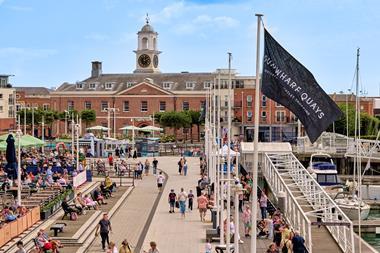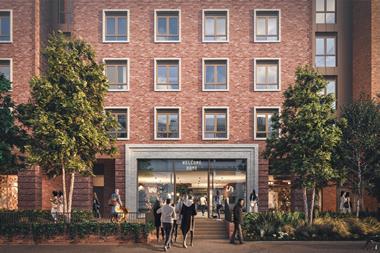Value retailers are moving out of town. Tiffany Holland finds out why, and looks at the implications as they switch focus from the high street.
The out-of-town retail mix used to be predictable – names such as Carpetright and Halfords would appear regularly, and many high street retailers would steer clear of big boxes.
But recently, out-of-town retail parks have been undergoing a transformation. Retailers such as DIY chain Focus have been pushed out of the market and customer
behaviour has changed dramatically – value retailers such as 99p Stores, B&M Bargains, Poundworld and Wilkinson are now among the main acquirers of retail park space across the UK.
“Quite a lot of these retailers started life on the high street,” says Rob Asbury, head of retail and leisure at property consultancy Montagu Evans. “They realised with the administrations caused by the recession, particularly with the collapse of Focus last year, there was a lot of property.
“They found it was a quick way to acquire stores and build up locations, so they are certainly leading the way in terms of filling space.”
Johnny Rowland, director of out-of-town retail at property agent Savills, agrees. He says value retailers have helped fill the gaps left by retailers hit by recession: “In the last three years discounters have really appeared on the scene. It started off with The Range opening stores, which was driven by the demise of bigger space users such as Courts and Focus.”
B&M Bargains began life on the high street with 2,000 sq ft stores, but has acquired a clutch of Focus stores as large as 26,000 sq ft.
99p Stores and Poundworld, which have both branched out to retail parks with new formats Family Bargains and Discount UK, both offer extended propositions compared with their high street stores.
There is a key difference in costs that also attracts retailers. Rowland explains: “Although landlords could raise rents, there has been no rent review going up since 2007.” Asbury adds that retailers in out-of-town parks can often get more space for a lower cost than on the high street.
Value retailers have boomed during the recession as customers’ attitudes towards them shifted, and are keen to grow their store estate as a result.
Poundworld property director Mark Ward says: “With customers feeling the pinch over the last two years, the desire for them to grab a bargain has increased and there has certainly been a positive shift in people’s views.
“We feel that with a bigger space and the opportunities on retail parks we can offer the customer a greater choice.”
However, the value retailers have had to win over landlords, who before the recession may not have wanted a value proposition on their parks.
“Three to five years ago the landlords and some tenants might have had a bit of a snooty view of the value retailers,” says Asbury.
“But a lot of them have very good covenants and good trading. They actually generate footfall, pulling in customers as you might expect an anchor trader like B&Q or Next to do. The other retailers are therefore benefiting.”
Ward agrees, saying that many landlords are often surprised by the quality of Poundworld shopfits and the products they sell.
“The biggest improvement landlords see is the significant surge in footfall we generate,” he adds.
Furniture retailer CSL Sofas trades mainly on retail parks but started life on the high street. Managing director Jason Tyldesley says: “There is a massive barrier to entry on out-of-town retail parks if you’re not a well-known retailer, but landlords’ attitudes are changing.
“These days you have to have a huge covenant or locate in a retail park that isn’t as prime as you wanted. It has taken us many years and a lot of effort to become a preferred store on out-of-town locations and now we get purpose-built units instead of taking any space we’re offered.”
But, he says, CSL “actively avoids” retail parks that include value retailers . “Great value isn’t a bad thing but if it changes the type of clientele shopping on the site it’s not great for a high-ticket retailer like us.”
Neil Varnham, fund director at retail property fund management firm Pradera, says the perfect retail park mix should include a leisure offer in
the form of a cinema and a coffee shop and some big-name retailers such as Boots, alongside a value presence. “But the key is not to have too many
discounters,” he adds.
Demand for retail park space is not just coming from the discounters. Fashion and home retailer Next, Boots and sports retailers are still acquiring out-of-town locations, where bigger stores tend to generate higher turnover and retailers can offer customers extended ranges and exclusive products.
A Next spokesman says it wants to open larger stores on retail parks that have a DIY and gardening offer, complementing its in-town stores.
“The ease of access and extended trading hours attract customers to out-of-town locations and the size of unit available has created a development opportunity and allowed Next to open fantastic new stores such as the one in Ipswich Martlesham Heath,” he says.
“Evidence would suggest that the home customer tends to look out of town rather than in town when wanting to make a significant purchase. Next has increased the number of Home standalone stores to meet this demand.”
There are likely to be more shifts to out-of-town locations, and Asbury believes discounters are here to stay. However, he cautions: “A lot of the discounters sell the same products and that cannot be sustained for too long. But people’s shopping habits have changed and will change, so it is going to be very interesting.”
And the growth of online shopping has led many retailers to realise they do not need to operate as much physical trading space as they once did. Varnham says: “If we go back 20 years, retailers used to think they needed 250 locations across the UK to get good coverage. Now, 80 stores are enough.”
As shopping habits change, so will retailers’ requirements – out-of-town stores will become a core part of a growing number of retailers’ businesses.
Out of town vs high street
High streets have been hit hard by the recession, and the current vacancy rate at a record 14.6%. But retailers are committed to such locations. Poundworld property director Mark Ward says since January this year the retailer has opened 44 stores and 80% were on high streets.
But Marks & Spencer director of property Clem Constantine says retailers will go where the location is right.
“The high street needs investment. If a town centre is allowed to die, it doesn’t help us with our decision about where to locate a store,” he comments.
M&S aims to increase space between 2% and 5% by 2015 and is looking in and out of town. Although M&S has just 25 stores located out of town out of more than 700 stores in total, it recently opened its Cheshire Oaks big box store to test its multichannel vision.
Constantine believes town centres are struggling to rejuvenate themselves, which could push customers to travel out of town.
“People want to go where it is easy to shop, which includes easy parking, well-lit areas and a leisure offering, but if the high street doesn’t have that then they will travel further out.”
CSL managing director Jason Tyldesley believes high streets and retail parks should complement each other rather than seeing them as rival retail locations.
“The perception is that retail parks are dangerous,” he says. “But the locations need to be integrated.”


























No comments yet